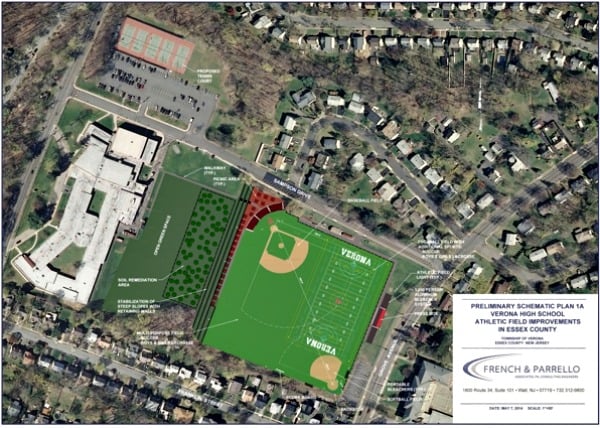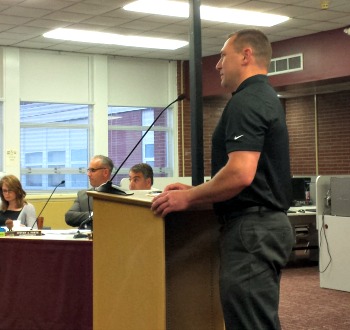 By September 1, 2016, Verona’s public schools will have doors that can do background checks, energy-efficient LED lighting, new sidewalks and paving, and a revitalized outdoor space for sports and activities. Before then, we’ve got a lot of work to do.
By September 1, 2016, Verona’s public schools will have doors that can do background checks, energy-efficient LED lighting, new sidewalks and paving, and a revitalized outdoor space for sports and activities. Before then, we’ve got a lot of work to do.
Just how much work was outlined Tuesday night, at the final Verona Board of Education meeting for Superintendent Steve Forte, who spearheaded the referendum that will fund all this work. (Forte becomes the superintendent in Denville on July 1.) Paul McDevitt, the schools’ facilities director, said that work was well underway on all seven aspects of the referendum. And he dispelled one of the rumors about the project that has been circulated by its opponents: That 100 trees would be cut down between the upper and lower fields at Verona High School as part of the remediation of those fields.
The New Jersey Department of Environmental Protection, which had to weigh in on the work because of the contaminated infill on the upper field, has determined that Verona does not have to build a full retaining wall along its eastern side. Had Verona had to do so, many of the trees between the two fields would have had to be cut down. Ironically, most of the trees now in the woods are Norway maples, a tree that has been branded as an invasive nuisance by the NJDEP.

McDevitt said that construction documents for the field work would be ready this August and that the work would go out to bid in January, with the project to be completed by August 2015. The new lower field will have aluminum bleachers along the east side with seating for 1,200, somewhat more than the bleachers that have been rented for the past two football seasons. The semi-circle of cement bleachers behind home plate would be refurbished and a line of picnic tables added up top, though not as many as had been scoped out in the concept plan because more trees are now being retained. (BOE member Joe Bellino asked at the June 10 meeting for trees to be added along Sampson Drive, Grove Avenue and Franklin Avenue, which is also not shown on the concept plan.)
There will be eight light poles installed around the field, which will make it possible to hold night football games but not night baseball because that sport needs additional lighting. The field turf would be permanently marked for football, baseball and lacrosse, but other striping can be added as needed. Forte said after the June 10 meeting that the field will also have portable bleachers that could add up to 400 seats on the visitors side of the football field, and that the plan does not now call for a field house or permanent bathrooms on the lower field. A paved path would lead from the fields to the back of VHS, where bathrooms are available.
Perhaps the most futuristic aspect of the referendum work will be the security systems coming to all schools. When completed, visitors will scan their driver’s license through a reader, which will send information to several databases for a background check. If that is satisfactory, the visitor will be admitted to a secured vestibule, where staff will gather more information about the purpose of the visit before letting the person fully into the building. The electronics needed for the security systems will begin to be installed this summer, but because vestibules and admitting areas need to be built at every school except Laning, the security systems may not be fully operational until the start of the 2015-2016 school year. The security upgrades will also include cameras and motion sensors, which will control hallway lighting as well. McDevitt said that school staff have seen demonstrations of some of the equipment already, which he thought had allayed apprehension about it.
In other projects, general building repairs to ceilings, paving and masonry could begin in August, and McDevitt said the upgrades to the kitchens at VHS and H.B. Whitehorne would go out to bid in January. The architects for the 1,500 square foot expansion of the music room are refining their design and construction should begin in spring 2015.
Equipment for most of the tech upgrades, which include WiFi in all buildings and a new phone system at VHS, has been ordered and should be completed by the end of 2014. Cindy Costanza, the district’s technology manager, said she expects that only the installation of the backup generator will extend into next year.
The new mechanical systems to be installed at VHS to replace the school’s 58-year-old boiler have the longest timeline. The referendum will replace all equipment put in before 2007 with energy-efficient heating and lighting, and all lights across the district will be converted to LED, which could cut Verona’s energy bill by up to 70%. McDevitt said that all pipes now in VHS will be tested: If they are in good condition, they could be retained and create some savings. If they need to be replaced, the work will stay on budget but be more intrusive. That could mean that 2015 summer programs at VHS would have to be moved to a different location. All mechanical work will be complete by Sept. 1, 2016.
McDevitt’s full presentation should be available later today on the Referendum Information page of the school Web site.

